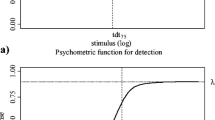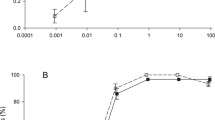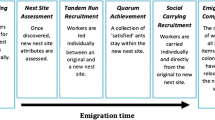Abstract
Several glandular sources of trail pheromones have been discovered in army ants in general. Nevertheless, at present the understanding of the highly coordinated behavior of these ants is far from complete. The importance of trail pheromone communication for the coordination of raids and emigrations in the ponerine army ant Leptogenys distinguenda was examined, and its ecological function is discussed. The secretions of at least two glands organize the swarming activities of L. distinguenda. The pygidial gland is the source of an orientation pheromone holding the group of raiding workers together. The same pheromone guides emigrations to new nest sites. In addition, the poison sac contains two further components: one with a weak orientation effect and another which produces strong, but short-term attraction and excitement. The latter component is important in prey recruitment and characterizes raid trails. This highly volatile recruitment pheromone allows the extreme swarm dynamic characteristic of this species. Emigration trails lack the poison gland secretion. Due to their different chemical compositions, the ants are thus able to distinguish between raid and emigration trails. Nest emigration is not induced chemically, but mechanically, by the jerking movements of stimulating workers.
Similar content being viewed by others
REFERENCES
Beckers, R., Deneubourg, J. L., Goss, S., and Pasteels, J. M. (1990). Collective decision making through food recruitement. Insectes Soc. 37: 258–267.
Billen, J. (1992). Origin of the trail pheromone in Ecitoninae:Abehavioural and morphological examination. In Billen, J. (ed.), Biology and Evolution of Social Insects, Leuven University Press, Leuven, pp. 203–209.
Billen, J., and Gobin, B. (1996). Trail following in army ants (Hymenoptera, Formicidae). Netherlands J. Zool. 46(3- 4): 272–280.
Blum, M. S., and Portocarrero, C. A. (1964). Chemical releasers of social behavior. IV. The hindgut as the source of the odor trail pheromone in the Neotropical army ant genus Eciton. Ann. Entomol. Soc. Am. 57: 793–794.
Bonabeau, E. (1997). Flexibility at the edge of chaos: A clear example from foraging in ants. Acta Biotheor. 45: 29–50.
Bonabeau, E., Theraulaz, G., and Deneubourg, J. L. (1998). Group and mass recruitment in ant colonies: The influence of contact rates. J. Theor. Biol. 195: 157–166.
Chadab, R., and Rettenmeyer, C.W. (1975). Mass recruitment by army ants. Science 188: 1124–1125.
de Biseau, J. C., Deneubourg, J. L., and Pasteels, J.M. (1992). Mechanisms of food recruitment in the ant Myrmica sabuleti: An experimental and theoretical approach. In Billen, J. (ed.), Biology and Evolution of Social Insects, Leuven University Press, Leuven, pp. 359–367.
Deneubourg, J. L., and Goss, S. (1989). Collective patterns and decision-making. Ethol. Ecol. Evol. 1: 295–311.
Deneubourg, J. L., Goss, S., Franks, N., and Pasteels, J. M. (1989). The blind leading the blind: Modeling chemically mediated army ant raid patterns. J. Insect Behav. 2: 719–725.
Gotwald, W. H., Jr. (1995). Army Ants: The Biology of Social Predation, Cornell University Press, Ithaca, NY.
Hőlldobler, B., and Engel, H. (1978). Tergal and sternal glands in ants. Psyche 85: 285–330.
Hőlldobler, B., and Wilson, E. O. (1990). The Ants, Belknap Press of Harvard University Press, Cambridge, MA.
Jessen, K., Maschwitz, U., and Hahn, M. (1979a). Neue Abdominaldrüsen bei Ameisen I. Ponerini (Formicidae: Ponerinae). Zoomorphologie 94: 49–66.
Jessen, K., Maschwitz, U., and Hahn, M. (1979b). Neue Abdominaldrüsen bei Ameisen I. Ponerini (Formicidae: Ponerinae). Zoomorphologie 94: 49–66.
Maschwitz U., and Mühlenberg, M. (1975). Zur Jagdstrategie einiger orientalischer Leptogenys-Arten (Formicidae: Ponerinae). Oecologia 20: 65–83.
Maschwitz, U., and Schönegge, P. (1983). Forage communication, nest moving recruitment, and prey specialization in the oriental ponerine Leptogenys chinensis. Oecologia 57: 175–182.
Maschwitz, U., Steghaus-Kovac, S., Gaube, R., and Hänel, H. (1987). Eine Treiberameise in der Unterfamilie Ponerinae: Erste Untersuchungen zur Biologie von Leptogenys sp. 1 nahe L. mutabilis. IUSSI, 11. Tag. Deutschspr. Sekt., Bayreuth, p. 24.
Maschwitz, U., Steghaus-Kovac, S., Gaube, R., and Hänel, H. (1989). A South East Asian ponerine ant of the genus Leptogenys (Hym., Form.) with army ant life habits. Behav. Ecol. Sociobiol. 24: 305–316.
Moffett, M.W. (1987). Sociobiology of the Ants of the Genus Pheidologeton, Ph.D. dissertation, Harvard University, Cambridge, MA.
Oldham, N. J., Morgan, E. D., Gobin, B., and Billen, J. (1994). First identification of a trail pheromone of an army ant (Aenictus species). Experientia 50: 763–765.
Parry, K., and Morgan, E. D. (1979). Pheromones of ants: A review. Physiol. Entomol. 4: 161–189.
Steghaus-Kovac, S. (1994). Wanderjäger im Regenwald—Lebensstrategien im Vergleich. Őkologie und Verhalten süudostasiatischer Ameisenarten der Gattung Leptogenys (Hymenoptera: Formicidae: Ponerinae), Dissertation, J. W. Goethe-Universität, Frankfurt am Main.
Topoff, H., Mirenda, J., Droual, R., and Herrick, S. (1980). Behavioural ecology of mass recruitment in the army ant Neivamyrmex nigrescens. Anim. Behav. 28: 779–789.
Torgerson, R. L., and Akre, R. D. (1970). The persistence of army ant chemical trails and their significance in the ecitonine-ecitophile association (Formicidae: Ecitonini). Melanderia 5: 1–28.
Watkins, J. F. (1964). Laboratory experiments on the trail following of army ants of the genus Neivamyrmex (Formicidae: Dorylinae). J. Kans. Entomol. Soc. 37: 22–28.
Wilson, E. O. (1971). The Insect Societies, Belknap Press, Cambridge, MA.
Witte, V. (2001). Organisation und Steuerung desTreiberameisenverhaltens bei Südostasiatischen Ponerinen der Gattung Leptogenys, Dissertation, J.W. Goethe-Universität, Frankfurt/Main (published on WWW).
Witte, V., and Maschwitz, U. (2000). Raiding and emigration dynamics in the ponerine army ant Leptogenys distinguenda (Hymenoptera: Formicidae). Insectes Soc. 47: 76–83.
Author information
Authors and Affiliations
Corresponding author
Rights and permissions
About this article
Cite this article
Witte, V., Maschwitz, U. Coordination of Raiding and Emigration in the Ponerine Army Ant Leptogenys distinguenda (Hymenoptera: Formicidae: Ponerinae): A Signal Analysis. Journal of Insect Behavior 15, 195–217 (2002). https://doi.org/10.1023/A:1015484917019
Issue Date:
DOI: https://doi.org/10.1023/A:1015484917019




